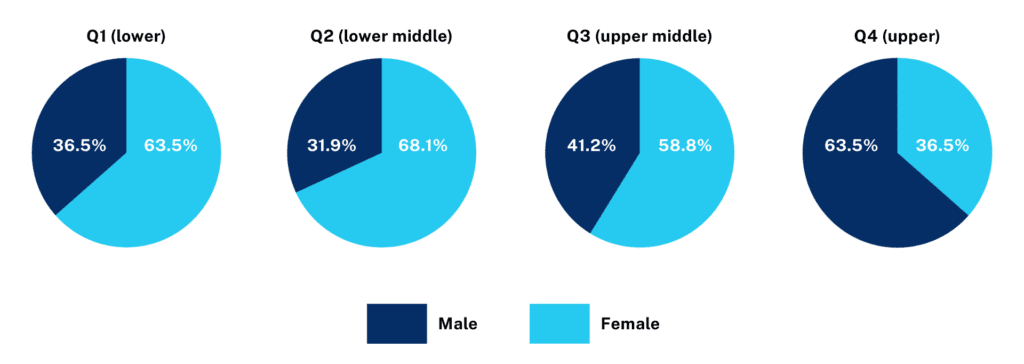Measuring the Gender Pay Gap
A gender pay gap is the difference in the average paid to an organisation’s male and female employees. It does not consider the nature of an employee’s work or their seniority within an organisation.
It’s also not the same as an equal pay comparison, which would compare the pay awarded to male employees and female employees doing the same, similar, or equivalent work. For example, an organisation paying men and women equally at each level of seniority can still have a gender pay gap, if there are fewer women working at higher levels.
How are the median and mean gaps calculated?
We have calculated the median and mean gaps according to the gender pay gap reporting regulations. This means we’ve taken a snapshot of pay data on 5 April 2024, then cross referenced this against whether individuals define themselves as male or female.
To calculate the median gap we hypothetically line up all our male employees in one line, and our female employees in another. The median gender pay gap is the difference in pay between the female employee in the centre of the line and the male colleague in their line.
The mean gender pay gap is calculated by comparing the average hourly rate of pay between male and female employees. The same approach is used to compare the difference in median and mean bonus pay. However, rather than taking a snapshot of a single day, this is based on bonus pay in the 12-month period to 5 April 2024. The percentage of male and female employees awarded bonus pay over the same period is also recorded.
How are the pay quartiles calculated?
This report also includes details of the percentage of male and female employees in each pay quartile, for example the gender split of those in the highest paid quarter of employees, the second highest quarter, and so on.
What’s included in our calculations?
In line with Government guidance, our median and mean pay calculations, and our calculations of quartile pay bands, are based on data from April 2024 only, including ordinary pay and bonus pay. Ordinary pay includes basic pay as well as pay for leave. It does not include pay given in lieu of leave, paid overtime, pay relating to redundancy/termination of employment, or the value of benefits in kind. Bonus pay includes any additional pay awarded to individuals for exceptional performance. In our case the bulk of bonus pay is awarded under our annual bonus scheme.
Understanding our results
Percentage of men and women in each hourly pay quarter:

Pay Gap
Bonus Gap

Understanding The Gap
We’re extremely encouraged to see that all aspects of our gender pay gap for hourly pay have improved and the overall results stem from several key factors.
Growth
We are pleased to see the increase in women in senior roles at HF, resulting in more females in the upper pay quartile and a decrease in the pay gap.
As part of our focus on sustainability, including diversity, inclusion and social mobility, we’ve continued to develop our talent pipeline through legal apprenticeships. During the reporting period we recruited 28 legal apprentices, of whom 22 were female. This gives us a larger percentage of females at the lowest end of the pay scale but with our continued commitment and emphasis on promoting from within HF, it gives us a very promising pipeline of talent coming through the organisation.
Career Development & Progression
We continue our long-term commitment to developing our people and promoting from within HF. As part of that strategy, ongoing promotion of women across all levels has seen women representing 58% of promotions to Associate, 64% of Senior Associates, 50% of Associate Partners and 33% of Partners.
Our pipeline of talent, particularly female talent, is building from the bottom up and that is resulting in a year-on-year increase in the number of female Partners/Directors (2022 – 14.5%; 2023 – 19%; 2024 – 23%; 2025 – 25%).
We remain committed to accelerating that change, with recruitment and development frameworks and processes supporting the HF culture of inclusivity and diversity, and offering the opportunity to succeed in law based on merit and regardless of gender, background, beliefs, disabilities or any other factor.
Flexible Working & Maternity Leave
Our range of genuine flexible, hybrid working options and additional support during maternity leave are two of the most important enablers facilitating progression across our business and we’re constantly developing and promoting our benefits to provide the best possible support.
Enhanced maternity and adoption leave and flexible working options that offer extended start and finish times, compressed hours, weekend working and temporary part-time hours during school holidays, help our people better manage their work life balance and caring responsibilities. This allows men and particularly women to thrive and progress in their chosen career path.
Currently 13.1% of women employed by HF take advantage of one of our flexible working options compared to 2.5% of men.
Employee Networks
Women at HF is one of our employee networks, with a high level of activity and engagement. At a strategic level they help direct policies and initiatives to help improve gender equality, as well as providing support, information, events and a forum for discussion and exchange of thoughts and ideas.
The group has recently helped look at how we improve our support for employees going through the menopause, with the aim of helping to support and retain women and support their progression into senior roles. Our Menopause Support Hub now provides individuals with helpful information to navigate menopause while continuing to thrive in their role. We’ve also delivered menopause awareness training sessions to everyone across HF, including a session specifically aimed at line managers enabling them to be as supportive as possible.
The Women at HF network will continue its great work, alongside our other employee networks, to ensure we work together to provide gender equality and a genuinely inclusive culture for all.
Limited company status
Unlike most other UK law firms, we are a limited company. As a result, we do not have equity partners who traditionally are the highest earners but who can legitimately be excluded from the gender pay gap figures of those law firms. This can, of course, significantly skew the figures.
At HF, every individual is included in our figures in line with our Limited Company Status – a change which was made to facilitate our all-employee share scheme.
See our previous reports:




